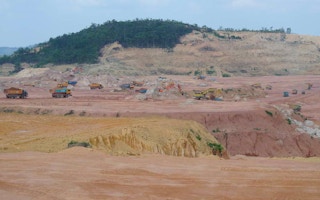Access to technology and knowledge about forests is necessary for communities and smallholder farmers to achieve sustainable forest management and halt deforestation.
A new report by the FAO (UN Food and Agriculture Organization), stressing the significance of forest monitoring and restoration, highlighted the Asia-Pacific Forestry Week (22-26 February) at the Clark Freeport Zone in Pampanga.
It was the first major regional conference to discuss what the Paris Agreement under the UN Framework Convention on Climate Change means for forestry in Asia-Pacific countries.
“The Asia-Pacific is the only developing region of the world to be seeing an increase in forest cover but the performance record is uneven,” Patrick Durst, senior forestry officer at the FAO, tells SciDev.Net.
“A few countries such as China, the Philippines and Vietnam posted significant increases in forest area but many countries continue to lose forest area at an alarming rate.”
One stark example are mangroves — a key resource used to protect people from climate change but which are themselves vulnerable to that change, says Daniel Murdiyarso, a senior scientist at the Center for International Forestry Research (CIFOR) and former environment deputy minister of Indonesia.
Murdiyarso presented a study he co-authored on a global data review of mangroves, which was recently published in the journal Wetlands Ecology and Management.
Using this century’s projected sea level rise published in the Intergovernmental Panel on Climate Change Fifth Assessment Report (IPCC AR5), the study found that some mangroves, such as fringe mangrove forests which can be found all over the Pacific small island developing states, are more vulnerable to sea level rise than others.
If no interventions are implemented, fringe mangroves can survive in a high scenario of sea level rise only until 2055 while its counterpart, the interior mangroves, can survive slightly longer – until 2070.
“
Despite the Asia-Pacific region being home to almost half of the global mangroves, we have to ‘turn the tide’ – technically, institutionally and legally speaking.
Daniel Murdiyarso, senior scientist at Center for International Forestry Research
“Despite the Asia-Pacific region being home to almost half of the global mangroves, we have to ‘turn the tide’ – technically, institutionally and legally speaking,” Murdiyarso tells SciDev.Net.
“A lot needs to be done. Coordination between government agencies and collaboration with fishing communities need to be strengthened and more target oriented.”
The Asia-Pacific Forestry Week, a project of the FAO’s Asia-Pacific Forestry Commission (AFPC), has been held periodically since 1949 with the host country alternating among the sub-regions of the Asia-Pacific. The event is held in conjunction with the formal meeting of 33 member countries within the APFC.
Over 1,000 people attended the conference, making it the largest gathering of forestry professionals in the region this year, according to Durst. Participants included representatives from NGOs, academia, governments and the private sector. Over 70 events were held during the week-long activity.
Durst says, this year, the Philippines was chosen to host the event given the bold measures it has taken to address forest management issues, such as the national greening programme.










